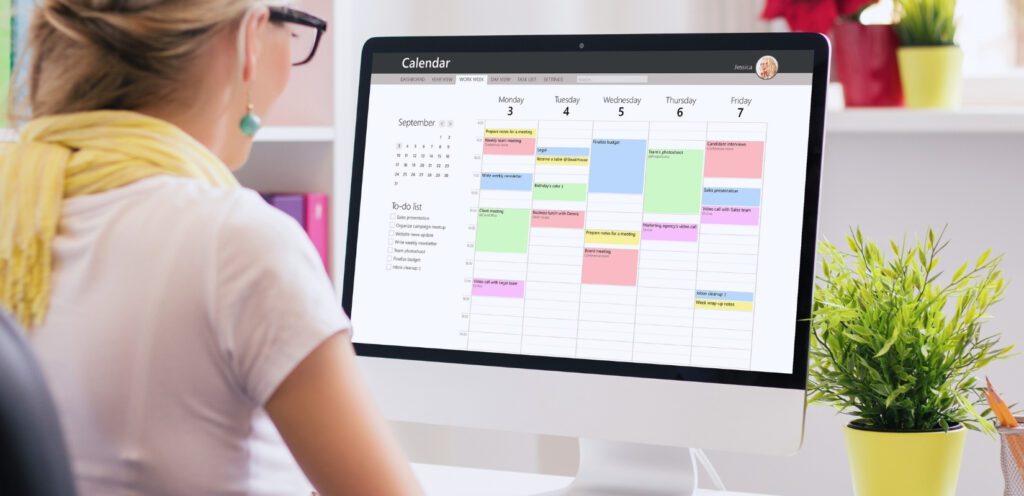Managing your time can sometimes feel like an impossible task when you’re a busy woman. Between balancing work, family, and personal care, how can you get everything done? That’s where implementing effective time management strategies can help you find a sense of balance while staying productive.

This post is all about the 7 simple time management strategies to help you streamline your tasks, boost your efficiency, and make the most of every day.
Let’s dive in and explore how you can take back control of your time!
7 Simple Yet Mighty Time Management Strategies for the Busy Woman
This post may contain affiliate links, which means I’ll receive a commission if you purchase through my links, at no extra cost to you. Please read full disclosure for more information.

1. Prioritize To-Do List Tasks with the Eisenhower Matrix
“I have two kinds of problems, the urgent and the important.”
– Dwight D. Eisenhower (34th U.S. President)
When you’re overwhelmed with tasks, the initial brain-dump of creating a to-do list feels great! But, the greatest weakness of any to-do list is that when everything and anything is added, the list has the potential to never.end.
This is where using the Eisenhower Matrix can really help! The key benefit of this matrix is that you’ll know which tasks you need to tackle first based on their urgency and importance.
The Eisenhower Matrix categorizes tasks into four quadrants:
- Quadrant 1: Urgent and Important (Do First) – Tasks that need immediate attention. These are typically crises or deadlines.
- Quadrant 2: Important but Not Urgent (Schedule) – Tasks that are important for long-term goals but don’t require immediate action. This includes planning, learning, and relationship-building.
- Quadrant 3: Urgent but Not Important (Delegate) – Tasks that need to be done quickly but aren’t crucial to your goals. These are often interruptions or distractions.
- Quadrant 4: Not Urgent and Not Important (Eliminate) – Tasks that are neither important nor urgent. These activities are often time-wasters.
How to Use the Eisenhower Matrix:
- List Your Tasks: Write down all the tasks you need to accomplish.
- Categorize Each Task: Place each task into one of the four quadrants of the matrix.
- Prioritize Your Tasks: Focus on tasks in the “Urgent and Important” quadrant first.
- Schedule Important but Not Urgent Tasks: Allocate specific time slots for these tasks.
- Delegate When Possible: Assign tasks in the “Urgent but Not Important” quadrant to someone else, if you can.
- Eliminate Unnecessary Tasks: Minimize or remove tasks in the “Not Urgent and Not Important” quadrant.

2. Use the 2-Minute Rule for Quick Wins
“If an action will take less than two minutes, it should be done at the moment it’s defined.”
– David Allen, Getting Things Done
Coined by David Allen in his book ‘Getting Things Done,’ the 2-Minute Rule is a strategy that suggests if a task can be completed in two minutes or less, it should be done immediately. This is a small but powerful technique that can help with several things:
- It encourages immediate action.
- It helps prevent small tasks from accumulating and consuming more time later.
- It helps to clear your mind to focus on more important activities.
How to Implement the 2-Minute Rule
- Identify Quick Tasks: As you go through your day, identify tasks that can be completed in two minutes or less, such as replying to an email or making a quick phone call.
- Take Immediate Action: Whenever you encounter a task that fits the 2-Minute Rule, do it right away. This helps keep your to-do list manageable and prevents procrastination.
- Incorporate into a Routine: Make the 2-Minute Rule a habit by regularly scanning your environment and tasks for quick actions. Over time, this will become second nature.

3. Utilize Time Management Tools Effectively
When you have a lot going on, finding a balance between simplicity and effectiveness is the key. The right tools will help you organize tasks, stay focused, and improve your time management.
Here are some tools to help you manage your time:
- Notebooks: A simple notebook, like the popular LEUCHTTURM1917 journal or the PAPERAGE Dotted Journal Notebook, is great for jotting down daily to-do lists or daily reminders.
- Digital Calendar: My personal favorite is a digital calendar. Whether it’s your mobile calendar app, Outlook, or Google Calendar is a no-frills way to help you consolidate your tasks, schedule important dates, set reminders, and block your time (see tip #5!).
- Time Management Apps: If you’re juggling multiple projects or need a way to organize different task categories (like work—and home-related tasks), apps like Notion are a great place to start. You can tasks with deadlines, different priority levels, and project categories.
How to Use Time Management Tools Effectively
- Choose Tools Based on Your Needs: The tools you decide to use will depend on what you’re looking for. For example, if you need flexibility, you may prefer a digital calendar over a paper planner. Be sure to choose the tools that work best for meeting your needs!
- Integrate Tools into Your Routine: Make these tools a part of your daily workflow and test them to ensure they’re not disruptive to what’s really important: managing your time.
- Keep it Simple: When it comes to managing your time, keep everything as simple as possible. Nothing is more frustrating than trying to complete your tasks while managing 8 different apps. The tools should work for you, not against you.

4. Establish Efficient Productivity Systems
Having reliable systems in place can make a huge difference in streamlining your productivity. Our brains love systems because they reduce decision fatigue and are predictable. This is why something as simple as a morning routine can help you manage your time more effectively!
How to Develop Efficient Productivity Systems
- Set Clear Goals: Define what you want to achieve with your productivity systems. Do you need to manage your time better at work? Are you juggling too many things at home? Is your to-do list too overwhelming?
- Assess Your Current Systems: Observe your current systems and note what’s helping you and what isn’t. Do you already have any routines in place? What is your favorite part about that routine? What are its biggest challenges?
- Identify Changes You Want to Make: Look at your goals and identify what changes you need to make in order to reach them. What is causing you not to meet your goals?
- Start Small: Introduce one or two changes at a time. It can be tempting to overhaul your life completely, but this will not be sustainable in the long run. Start small and add new changes as you become more comfortable with them.
- Adjust as Needed: Review and adjust your system regularly. Your system should work for you and not add more stress!
Check out the following post for a step-by-step guide to designing your personal productivity system!
Related: Boost Your Efficiency in 5 Steps: Design Your Ultimate Productivity System

5. Boost Focus with Time Blocking
If you struggle with distractions or multitasking, time blocking can be a powerful technique for staying focused throughout the day. By setting aside dedicated time for specific tasks, you can enhance your focus and prevent multitasking.
How Time Blocking Works
- Identify Tasks: List all the tasks you need to complete, including work assignments, personal chores, and leisure activities.
- Create Time Blocks: Allocate specific time blocks for each task or group of tasks. For example, you might set aside 9:00 AM to 11:00 AM for focused work, 11:00 AM to 12:00 PM for meetings, and 1:00 PM to 2:00 PM for email responses.
- Stick to Your Schedule: Focus solely on the assigned task during each time block. Avoid multitasking and minimize interruptions.
- Review and Adjust: At the end of the day or week, review your schedule and adjust your time blocks as needed to improve efficiency.
How to Implement Time Blocking
- Plan Your Day in Advance: At the end of each day, plan your schedule for the next day. Identify key tasks and assign specific time blocks to each.
- Prioritize Tasks: Use your Eisenhower Matrix to prioritize tasks and ensure that high-priority tasks are allocated sufficient time.
- Set Clear Boundaries: Communicate your schedule to colleagues, family, or anyone who might interrupt you. Let them know when you are available and when you need focused time.
- Include Breaks: Schedule short breaks between time blocks to rest and recharge. This helps maintain productivity and prevents burnout.
- Be Flexible: While sticking to your schedule is important, be prepared to adjust your time blocks if unexpected tasks or emergencies arise.

6. Align Tasks with Your Menstrual Cycle
Understanding your menstrual cycle can be a game-changer for productivity and well-being. Because of the hormonal shifts that happen throughout your cycle, your energy levels, mood, and cognitive function can vary. And this natural rhythm can be used to your advantage!
Here are some examples of the best tasks to complete during each phase of your cycle.
Follicular Phase
- Energy Levels: Gradually increasing energy and creativity.
- Optimal Tasks: Brainstorming, strategic planning, and tackling new projects. Use this time for high-energy tasks, learning new skills, and engaging in social activities.
Ovulatory Phase
- Energy Levels: Peak energy, confidence, and social skills.
- Optimal Tasks: Collaboration, presentations, and networking. Schedule important meetings, negotiations, and activities requiring strong communication skills.
Luteal Phase
- Energy Levels: Energy may start high but can decline as the phase progresses.
- Optimal Tasks: Detailed work, completing projects, and managing tasks requiring focus. In the latter part of this phase, prioritize self-care and manage stress.
Menstrual Phase
- Energy Levels: Typically lower energy and a need for rest.
- Optimal Tasks: Focus on low-energy tasks, reflection, and planning. Use this time for administrative work, organizing, and reviewing your goals.
How to Align Tasks with Your Menstrual Cycle
- Track Your Cycle: Use apps or a calendar to monitor your menstrual cycle.
- Plan Accordingly: Adjust your schedule based on your energy levels and cognitive functions during each phase. For example, plan high-energy tasks during the follicular phase and more reflective tasks during the menstrual phase.
- Be Flexible: While planning around your cycle is beneficial, remain flexible to accommodate unexpected energy levels and workload changes.
- Self-Care: Incorporate self-care routines throughout your cycle. This might include adjusting your diet, exercise, and relaxation techniques to support your well-being.
Related: Are You Out of Sync?: The Ultimate Cycle Syncing Guide for Productivity

7. Delegate and Outsource Where Needed
Delegating and outsourcing tasks is a crucial strategy for managing your time effectively, especially for busy women juggling multiple responsibilities. You can focus on what matters and maximize your productivity by handing off certain tasks.
How to Delegate and Outsource Effectively
- Identify Tasks to Delegate: Determine which tasks can be handed off. These might include routine tasks, administrative work, or areas where others have more expertise.
- Choose the Right People: Select individuals or services with the skills and reliability to handle the tasks. These could be team members, freelancers, or specialized services.
- Set Clear Expectations: Clearly communicate the task requirements, deadlines, and expected outcomes. Provide all necessary information and resources.
- Monitor Progress: While it’s important to trust the person or service handling the task, regular check-ins can ensure that the work is on track and meets your standards.
- Provide Feedback: Offer constructive feedback to help the person improve and to refine the process for future delegations.
Tasks to Consider Delegating or Outsourcing
- Administrative Work: Tasks such as scheduling, data entry, and email management can be handled by an assistant or virtual assistant.
- Household Chores: To free up personal time, consider hiring help with cleaning, cooking, or other household duties. Or delegate to other family members and make chores a part of your regular household routine.
- Specialized Projects: Outsource tasks like graphic design, content writing, or IT support to freelancers or specialized agencies.
- Repetitive Tasks: Delegate routine tasks that do not require your direct involvement, such as inventory management or routine maintenance.
Concluding Remarks
This post was all about the 7 simple time management strategies to help you streamline your tasks, boost your efficiency, and make the most of every day.
Learning to manage your time effectively is a journey of trial and error. The best thing to remember is to keep it simple and don’t feel pressured to take on everything at once. But most importantly, be sure to take care of yourself along the way.
Now let’s hear from you! What is your favorite time management strategy, and how has it helped you? Share your thoughts or questions in the comments below!
Other Posts You May Like
Boost Your Efficiency in 5 Steps: Design Your Ultimate Productivity System
Are You Out of Sync?: The Ultimate Cycle Syncing Guide for Productivity
Leave a Reply